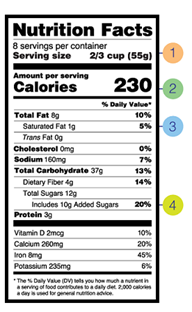By: Michelle Faber, NBC- HWC, EP-C
March is nutrition month, the perfect time to highlight some key features in the new nutrition guidelines that were released earlier this year by the United States Department of Agriculture and the United States Department of Health and Human Services.
According to the US Department of Health and Human Services, the 2020-2025 guidelines are the first that provide guidance for healthy eating from birth to older adult, and even include guidelines for pregnant and lactating women.
Why is it important to have these guidelines? They help promote a healthy eating lifestyle that can be maintained through all stages of life. The new format shifts us away from the diets that only last for a short amount of time—and all the information is backed by scientific evidence to support its claims. Below are some of the key features.
Four main nutrition guidelines
The major guidelines in this edition are:
- Follow a healthy dietary pattern at every life stage.
- Customize and enjoy nutrient-dense food based on your personal preference, culture and budgetary needs.
- Focus on meeting the food group needs with nutrient dense foods and beverages and staying within the calorie limit.
- Limit foods and beverages higher in added sugars, saturated fat, and sodium. Also limit alcoholic beverages.
These recommendations are all about finding an eating pattern that works for you. Fad diets can be short term fixes, and these guidelines will hopefully help bring about a lifestyle change through ALL stages of life. Some resources to help support you in this healthy eating lifestyle are Choose My Plate, Make Every Bite Count and more. Learn more about each specific guideline above here.
Nutrition label updates
Some other main changes are to the nutrition label. Let’s dive into more detail:
- The serving size is now bolded and some have even been adjusted (note: this is NOT a recommendation on how much to eat.)
 The calories are now shown in a larger and bolder font.
The calories are now shown in a larger and bolder font.- The percentage of daily values have been updated—5% DV or less of a nutrient per serving is considered low, and 20% DV or more of a nutrient per serving is considered high.
- Added sugars, vitamin D and potassium are now listed, and they removed “Calories from Fat” as the type of fat is more important than the amount.
All these changes will hopefully help people make more informed decisions on the food they’re eating. This is the first major change to the food label in almost 20 years.
A healthy eating style does not have to be overwhelming. Focus on one goal to work on for the next couple weeks. Maybe it’s learning and diving into some of the resources above, or picking one area of your plate to look at. It could also be paying greater attention to nutrition labels. ThinkHealth has a variety of tips and healthy eating recipes to try. Once you feel comfortable with that — challenge yourself again with another small step to make your nutrition choices a lifestyle change!
About the Author: Michelle Faber, NBC- HWC, EP-C is a national board-certified health and wellness coach on the wellness team at Priority Health. She has a passion for helping individuals find their motivation and purpose to make and sustain healthy lifestyle changes in all areas of life. Michelle is certified as an Exercise Physiologist through the American College of Sports Medicine and loves working with people who are managing chronic disease, pregnancy, and exercise in young children and families. She is also an Orthopedic Specialist through the American Council on Exercise.


